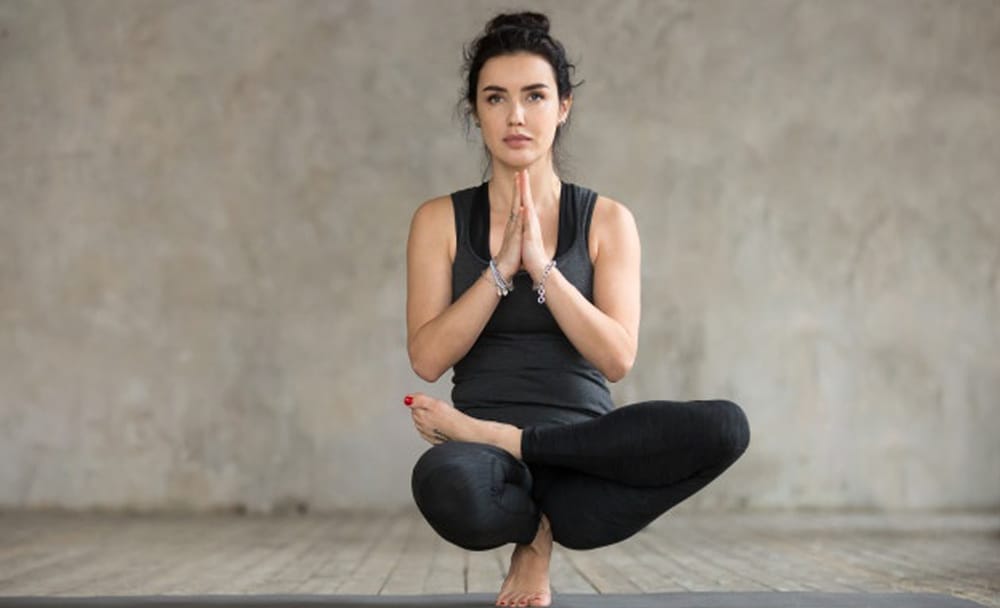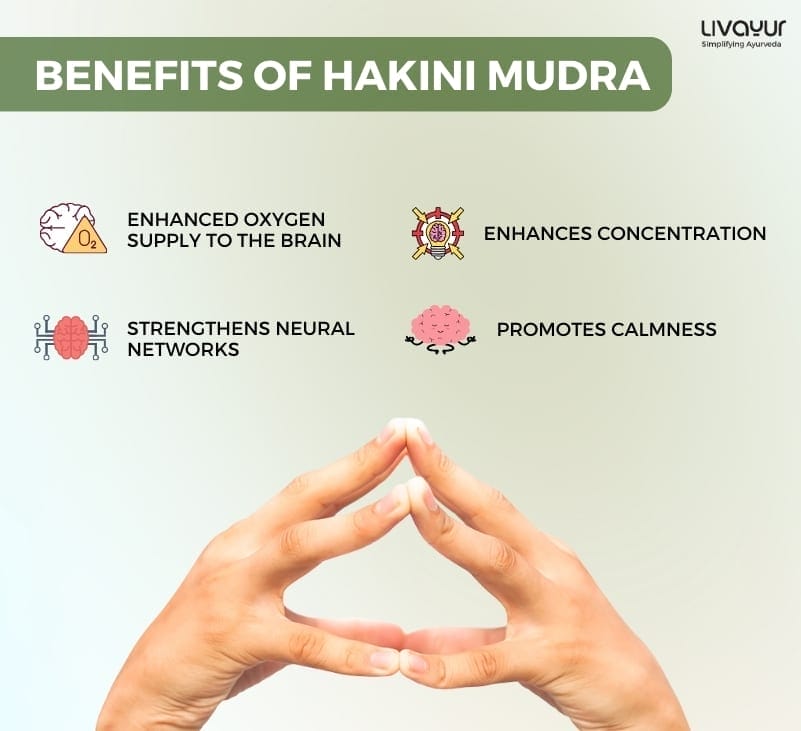मनःप्रशमनोपायो योग इत्यभिधीयते॥
The recourse to pacify the mind is called yoga
Yoga is an ancient practice that involves physical postures, breathing techniques and meditation. It helps to not only improve your physical health but also boost your mental well being. With regular practice of Yoga, you can prevent and treat several mental disorders such as stress, anxiety, depression, etc.
Benefits of Yoga for Mental Health
- Yoga helps to calm the nerves in your mind and reduce the instances of panic attacks and anxiety attacks, thereby significantly improving your mental health.
- It also helps to improve focus and concentration, which is very important for people suffering from mental health conditions such as ADHD.
- Yoga stimulates the production of healthy brain chemicals such as endorphins and dopamine, which help balance your mood and restore your inner peace. It is one of the main reasons why Yoga is considered highly beneficial for people suffering from depression.
- Yoga is also known to develop self-confidence and promote self-esteem, the lack of which is generally associated with anxiety problems.
- It helps to improve cognitive skills such as learning, retaining information (memory), attention, awareness, etc., thereby improving brain functions and promoting your overall mental health.
10 Best Yoga Poses for Mental Health
1. Shavasana (Corpse Pose)
It is one of the best Yoga Asanas for your mental health. It helps calm the nerves, improve concentration, promote patience and relax the body. Furthermore, Shavasana also helps to alleviate many gastrointestinal and respiratory problems.
How To Do Shavasana?
- Lie flat on your back while keeping your arms alongside and your eyes closed. Also, keep your legs slightly apart.
- Then, start taking deep breaths and concentrating on your body parts. Focus on your breathing rhythm as you continue to meditate.
- Stay in this Asana for 15-20 minutes, and then gradually release the pose and bring your focus back to your surroundings.
Precautions While Doing Shavasana
There are a few things to keep in mind when doing Corpse Pose:
- Make sure your mat is clean and free of any debris.
- Wear comfortable clothing that won’t restrict your movement.
- If you have any injuries or medical conditions, please consult your doctor before doing this pose.
- Be sure to practise in a quiet, uninterrupted space where you can completely relax.
People Who Should Avoid Doing Shavasana
- People are advised to not lay on their backs by their doctors or physiotherapists.
- Those who find it difficult to lie flat on the floor.
- People with severe acidity
- People having pain or injury.
2. Setu Bandhasana (Bridge Pose)
Setu Bandhasana is highly effective in removing mental blockages and promoting peace and calmness. Additionally, it also strengthens the muscles of the legs, thighs and back and relieves the symptoms of arthritis.
How To Do Setu Bandhasana?
- Lie down on your back and fold your knees to bring your legs closer to the hips. A straight line must be maintained between the knees and the ankles.
- Then, take a deep breath in and lift your back.
- Without bringing your chin down, aim at touching your chest with your chin. You may place your hands beside your body or use your palms to support your back.
- Stay in this posture for a few seconds as you keep taking deep breaths.
- Then, slowly exhale and release the pose.
Precautions While Doing Setu Bandhasana
- Make sure to practise this pose on an empty stomach for efficient results.
- Avoid practising this asana in a back injury.
- Don’t over-roll or stretch away from your shoulders from your ears to avoid neck soreness or sprain.
- Do not turn your head right or left when you are in the pose.
- Be careful while practising this asana if you are suffering from knee pain.
- Try to practise this asana under some professional guidance when performing for the first time.
People Who Should Avoid Doing Setu Bandhasana
- Do not practise this asana if you have a neck injury.
- People with severe migraines should avoid this pose.
- People with a weak stomach or intestine should avoid this pose as maximum pressure is put on the internal organs.
3. Uttanasana (Forward Bend Pose)
Uttanasana is considered one of the most therapeutic Yoga poses. It helps to alleviate stress and relax your body and mind. It is known to boost immunity and alleviate fatigue, headache and insomnia, which further contribute to your mental health. Uttanasana is also highly effective in strengthening calves, hamstrings and hips.
How To Do Uttanasana?
- Stand straight while maintaining a hip-width distance between your legs.
- Then, slowly start bending your body towards the ground while keeping your knees straight.
- Aim at touching the ground with your palms. Alternatively, you can also hold the ankles of your feet.
- Stay in this pose for a few breaths, and then gradually release the pose and stand straight.
Precautions While Doing Uttanasana
- Focus on pushing forward and down instead of backward to the legs.
- People with high or low blood pressure should transition in and out very gently.
- People with sciatica should keep a block under the heels, bend the knees and keep the chin lifted slightly.
- If one has lower back pain one should keep the navel in gently and support the hands-on block or floor properly so weight doesn’t fall upon the lower back.
People Who Should Avoid Doing Uttanasana
- People who are suffering from back pain, knee pain or any kind of surgery on the back.
- Pregnant women and women during menstruation
- People with any heart-related issues
4. Balasana (Child’s Pose)
Balasana helps alleviate stress, anxiety and other mental health problems while calming the nerves of your mind. It is also highly effective in stretching muscles and boosting blood circulation in your body.
How To Do Balasana?
- Sit on your heels with your knees pressed together.
- Then, inhale deeply and stretch your arms forward. Slowly start bending your upper body forward until your forehead touches the ground. Make sure your arms are in front of your body, with your palms facing down.
- Next, gently press your chest on your thighs while inhaling and exhaling deeply. Try to maintain your breathing rhythm.
- You may stay in this pose for as long as you want, till you feel relaxed.
Precautions While Doing Uttanasana
- Perform this asana only with an empty stomach.
- Put on comfortable clothing
People Who Should Avoid Doing Uttanasana
- People who are suffering from Diarrhea
- A High Blood Pressure patient
- People with a recent or deep injury in the feet, knees, thighs, spine or neck
5. Vajrasana (Diamond Pose)
Vajrasana is one of the best Yoga Asanas to reduce stress, improve concentration, enhance sleep quality and treat depression and anxiety. Additionally, it is also highly effective in improving digestion and relieving back pain in the body.
How To Do Vajrasana?
- Fold both your legs and sit down in a way that the heels of your feet touch your hips at the back. Make sure that your spine is always straight in this pose.
- Then, place your palms on your thighs and start inhaling and exhaling deeply.
- Practise this Asana for 10-15 minutes, and then gradually release the pose.
Precautions While Doing Vajrasana
- If you are new to Vajrasana, start with a few minutes and slowly increase the duration
- If you feel any pain or discomfort while practising Vajrasana, stop immediately
- Avoid sudden movements or jerks while transitioning in and out of the pose to avoid strain on the knees and ankles.
- Practise Vajrasana on a smooth texture, such as a yoga mat or blanket, to avoid discomfort or pressure on the knees and ankles.
People Who Should Avoid Doing Vajrasana
- Pregnant Women
- People With Digestive Issues
- People who have knee or ankle injury
6. Sukhasana (Easy Pose)
The base of your spine touches the earth when you sit in Sukhasana, which gives you a strong sense of groundedness. This posture’s symmetry also focuses on you. The symmetry of this posture also centres on you. These two factors combined aid you in overcoming anxiety as you feel that nothing can uproot you or knock you off balance.
Additionally, this pose is beneficial in preventing depression.
How To Do Sukhasana?
- Sit on the floor or a yoga mat with your legs crossed. Align your torso with your hips, making your spine straight and firm.
- Lengthen your tailbone and move your shoulders back and down.
- Rest your arms on your knees.
- Close your eyes and take deep, relaxed breaths.
- Focus your attention on your heartbeat.
As you sit in an easy pose, you can recite a mantra or watch your breath. Both of these are great methods for keeping your mind clear.
People Who Should Avoid Doing Sukhasana
- Those who have any hip or knee injuries or conditions
- People experiencing discomfort or pain in their lower back
7. Adho Mukha Svanasana (Downward Facing Dog Pose)
Adho Mukha Svanasana improves blood flow to the brain while strengthening your arms, shoulders, and legs and lengthening your spine. Increasing blood flow to this region gives you more energy and mental clarity, which helps you handle stressful or anxiety-inducing situations.
How To Do Adho Mukha Svanasana?
- Come to all four on your hands and knees with a flat back.
- Lift your hips by pushing against the ground with your toes.
- Straighten your legs and arms.
- Push against the ground with your hands to all your hips to rise.
- Your body should come to an inverted V-shape.
- If you feel tightness in your legs, you can bend your knees.
- After taking a few breaths, gently release the pose.
Precautions While Doing Adho Mukha Svanasana
- Perform a warm-up before you start the Adho Mukha Svanasana.
- Do not perform this pose on a full stomach.
People Who Should Avoid Doing Adho Mukha Svanasana
- People with wrist injuries
- Pregnant Women
8. Salamba Sarvangasana (Shoulderstand)
A shoulder stand, similar to the downward-facing dog stance, improves blood flow to the brain, which elevates mental clarity and emotional equilibrium.
How To Do Salamba Sarvangasana?
- Lie down on your yoga mat with your arms outstretched alongside your body.
- Bend your knees, raising your legs towards your chest.
- Press your hands into the floor to raise your bent legs over your head.
- Move your hands onto your back to support yourself as you move your hips farther towards your head, straighten your legs as you do so.
- Keep pressing your palms into your back; feel your body long and straight.
- Take several relaxing breaths here before gently releasing the pose.
Precautions While Doing Salamba Sarvangasana
- If you experience any pain while doing Shoulderstand, immediately stop and exit the pose.
People Who Should Avoid Doing Salamba Sarvangasana
- People with neck injuries
- People suffering from high blood pressure, glaucoma or retinal problems
9. Ushtrasana (Camel Pose)
The thorax, abdomen, inguinal region, and thighs are all stretched in the camel stance. This stance can instantly improve your mood and help you deal with symptoms of depression and anxiety. After practising the position, you will feel more at ease, optimistic, and prepared for anything life throws at you.
How To Do Ushtrasana?
- Kneel on the yoga mat and place your hands on the hips.
- Your knees should be in line with the shoulders and the sole of your feet should be facing the ceiling.
- As you inhale, draw in your tailbone towards the pubis as if being pulled from the navel.
- Simultaneously, arch your back and slide your palms over your feet till the arms are straight.
- Do not strain or flex your neck but keep it in a neutral position.
- Stay in this posture for a couple of breaths.
- Breathe out and slowly come back to the initial pose. Withdraw your hands and bring them back to your hips as you straighten up.
Precautions While Doing Salamba Ushtrasana
- Breathe normally throughout the practice.
- Avoid long and deep breaths as the chest is already stretched during this asana and taking long, deep breaths may create discomfort in breathing.
People Who Should Avoid Doing Ushtrasana
- People suffering from high or low blood pressure should avoid
- People suffering from insomnia
- People who have any back injury or pain in the neck.
- People who suffer from a migraine.
10. Chakravakasana (Cat-Cow Pose)
You can enhance your balance and posture by doing Chakravakasana. Since the movements of the position are linked with your breathing, it is also said to be a wonderful way to relieve tension and promote relaxation.
How To Do Chakravakasana?
-
Kneel on the floor and put your hands on the floor in front of you.
- Keep your hands shoulder-width apart and your knees directly below your hips.
- Inhale deeply while curving your lower back and bringing your head up, tilting your pelvis up like a “cow.”
- Exhale deeply and bring your abdomen in, arching your spine and bringing your head and pelvis down like a “cat.”
Precautions While Doing Salamba Chakravakasana
- This pose doesn’t cause any pain. Still, if you feel a certain level of pain then gently back out of the pose.
People Who Should Avoid Doing Chakravakasana
- People with recent abdomen or spinal column surgery
- People with a neck injury
The Takeaway
Regular practice of the Yoga poses mentioned above can help fight many mental disorders and boost your mental health. They help calm your mind, alleviate stress and boost your brain functions, thereby restoring the balance in your mind.
FAQs
Does yoga help mental health?
Yoga’s incorporation of meditation and breathing can help improve a person’s mental well-being.
How yoga can change your brain?
When you do yoga, your brain cells develop new connections, and changes occur in brain structure as well as function, resulting in improved cognitive skills, such as learning and memory.
Can yoga cure overthinking?
Various yoga mudras that can help you control overthinking
References:
- https://artoflivingretreatcenter.org/blog/7-easy-yoga-poses-for-depression-and-anxiety/
- https://www.healthshots.com/mind/happiness-hacks/international-day-of-yoga-10-yoga-asanas-for-happiness/
- https://www.mayoclinic.org/healthy-lifestyle/stress-management/multimedia/cat-cow-pose/vid-20453581
- https://www.vinyasayogaashram.com/blog/corpse-pose-savasana-how-to-do-it-benefits-precautions/
- https://rishikeshyogisyogshala.org/setu-bandhasana-pose-steps-and-benefits/
- https://www.vinyasayogaashram.com/blog/uttanasana-standing-forward-bend-how-to-do-it-benefits-step-by-step-instruction-precautions-and-safety/#:~:text=Uttanasana%20(Standing%20Forward%20Bend)%20Precautions,be%20in%20an%20elongated%20position.
- https://www.fitsri.com/poses/child-pose
- https://101yogasan.com/arthritis/birasana-and-sukhasana.htm
- https://www.thehealthsite.com/yoga/cat-cow-stretch-benefits-and-precautions-to-take-while-practising-chakravakasana-892751
- https://www.thehealthsite.com/fitness/yoga-asana/shoulderstand-salamba-sarvangasana-how-to-practice-benefits-and-precautions-865635/
- https://osteopathic.org/what-is-osteopathic-medicine/benefits-of-yoga/#:~:text=Yoga’s%20incorporation%20of%20meditation%20and,Nevins.
- https://www.health.harvard.edu/staying-healthy/yoga-for-better-mental-health#:~:text=When%20you%20do%20yoga%2C%20your,awareness%2C%20thought
- https://www.healthshots.com/fitness/staying-fit/how-yoga-can-help-in-stopping-overthinking/#:~:text=Some%20yoga%20mudras%20that%20can%20help%20you%20control%20overthinking&tex

























